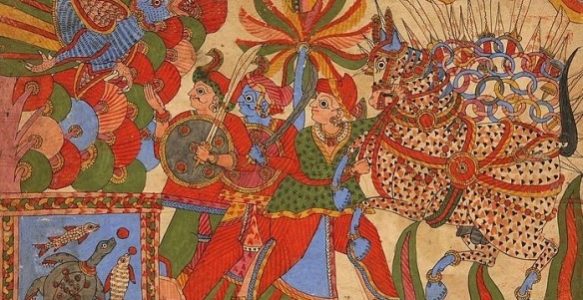Samantha Sawhney
The frame narrative of Valmiki’s epic, the Ramayana follows a regent of Ayodhya, King Dasharatha (दशरथ) and the four sons from his three principal wives: Kausalya (कौसल्या), Kaikeyi (कैकेयी), and Sumitra (सुमित्रा). In this paper, I will argue that the horse sacrifice or Aswamedha Yajna demonstrates that the incarnation of divinity takes an enlightenment of both the earthly and heavenly realms, causing a fundamental disruption.
When King Dasharatha initiates the horse sacrifice to have a son–as urged by the sage Rishyasringa (ऋष्यशृङ्ग)–the ritual is performed on a societal scale and each participant is essential to its function. Initially, he must prepare a sacrificial ground on the northern bank of the Sarayu [river] (1.7.5). The narrative then elaborates that he brings hosts of people to the city; among them are “[the] extremely pious king of Kekayas, the aged father of Dasharatha” (1.8.24) and “men from all lands” (1.8.21). The assembly of common men and kings in Ayodhya displays the significance of the event as one where the many orders of society gather. To an uninformed reader, this is the first allusion to the nature of the event being not only regal, but divine. The assembly of all men can be seen as a tentative facsimile of the Rg Vedic creation, wherein all societal orders are derived from the corpse of Purusha (पुरष), a giant. Except for, in this instance, mankind convenes in such a manner that affirms the interconnectedness of all beings and is unified to sacred, rather than being disconnected from it. The ritual derives is sanctimonial potency from the mass gathering of people and the collective divinity they possess.
The collectivism is also mirrored in the court of the gods. While King Dasharatha seeks to obtain an heir, the gods attempt to find a solution to kill the demon king, Ravana, who, “harass[es] all three worlds” (1.15.8). Many classes of divine beings, such as “Gandharvas, Siddhas, and the greatest of seers” (1.15.4), petitioned to Brahma (ब्रह्मा), which parallels the collectivism of kings and common men seen in Aswamedha Yajna.
Furthermore, King Dasharatha can be seen as an archetype of Brahma who facilitates the functioning of the heavenly sphere. Although the interests of King Dasharatha and Brahma are not completely aligned, they coincide in such a way that Vishnu as Rama (राम) incarnates to fulfill both simultaneously, for “his [Ravana’s] death has been ordained at the hands of man” (1.16.7) and “[d]esirous of getting a son […] the aforesaid monarch […] performed at that very time a sacrifice calculated to obtain a son” (1.16.9). The moment is one of perfection and the earthly incarnation is a fundamental disruption to both the mortal and divine realms. Rama then exists as an equalizing force to remedy some fundamental disharmony in both, requiring both societies to congregate and petition for his own incarnation to occur. Therefore, in sending Vishnu from the gods and into human society a profound disruption occurs in two realms. Divinity incarnate is fundamentally the essence of disruption to the narrow binaries set in post-Vedic epics, where rigid order is seen as essential to society’s proper function.
The elaborate and confounding ritual of King Dasharatha’s Aswamedha Yajna functions in tandem with the gods’ petitions of Brahma to agitate an abject interruption of the once orderly universe. The ritual temporarily destroys the adamant separations of Ramayanic society in an invocation of Rg Vedic creation, reuniting every piece of creation to receive a major divinity into their society. And that same deconstruction of separations is also seen in the heavenly court when Vishnu is asked to descend to Earth. Thus, King Dasharatha takes the role of Brahma as regent of Earth rather than that of the heavens. In tandem, the regents bring divinity into mankind and inadvertently display the union of the two realms. Ultimately, in the Ramayana, gods and men find a significant harmony in the Aswamedha Yajna.
Work Cited
Valmiki. Balakanda, Ayodhyakanda, Aranyakanda, and Kiskindhakanda. Sixteenth ed., Gorakhpur, India, Gita Press, 2022. Vol. 1 of Srimad Valmiki-Ramayana(With Sanskrit Text and English Translation). 2 vols.


